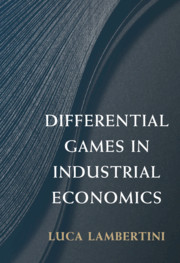3 - Oligopoly
Published online by Cambridge University Press: 29 March 2018
Summary
This chapter reviews differential games of different natures, sharing, however, a common feature: firms are assumed to control either quantities or prices and nothing else. Note that the evolution of applications of differential games has not been linear, so to speak. What I mean here is that while industrial economics has slowly moved away from basic oligopoly models describing quantity or price competition to account for richer and more sophisticated strategy spaces, differential games in IO left aside proper characterisation of what we are accustomed to consider as Bertrand and Cournot competition for quite some time, taking as departure points either models including several different control spaces at the same time or models where firms are indeed choosing output levels but never shoot right at the correct price level except asymptotically at equilibrium. Industrial economists started learning about differential oligopoly games thanks to Clemhout et al. (1971), where such things as consumer loyalty and market shares are already taken to be the relevant objects of analysis. And in the 1970s a large literature flourishes on themes connected with marketing and management, like advertising, which are reviewed in the next chapters. Then, Simaan and Takayama (1978) investigate the role of demand dynamics in the form of price stickiness, with many productive follow-ups.
Their model, frequently revisited, lends itself to be used as a ductile and malleable tool for the illustration of solution techniques as well as for helping us to understand properly how a state dynamics may condition the strategic behaviour of firms, and why it is relevant to adopt such a dynamic view. Put differently, in addition to its intrinsic value, the sticky price game allows one to grasp the difference between a static and a dynamic approach to a ‘simple’ oligopoly game, where ‘simple’ means that firms are just choosing output levels. This is the subject matter of Section 3.1, where quantity competition under price stickiness is investigated using several solution concepts, including nonlinear feedback strategies, also considering the case (empirically relevant but seldom considered in the theoretical literature) of hyperbolic demand functions.
Section 3.2 examines the opposite case, where demand is sluggish, while Section 3.3 illustrates games of capacity accumulation, where physical capital is a state variable for each firm and the structure is a strategic reinterpretation of dominant growth models in macroeconomics.
- Type
- Chapter
- Information
- Differential Games in Industrial Economics , pp. 55 - 100Publisher: Cambridge University PressPrint publication year: 2018

